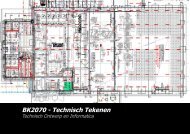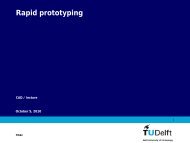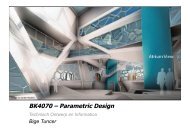•=•=•=Clarity/spatial organization – relationship between the five elements mentioned aboveAccessibility – accessibility of exits and placement of direction boardsSign<strong>in</strong>g system (<strong>in</strong>formation form) – frequency of <strong>in</strong>formation signs but also the presence ofdist<strong>in</strong>ctive spatial characteristics, which can enhance the orientation by provid<strong>in</strong>g adirectional differentiation. This may be an asymmetry or variation of heights and widths, or(day)light <strong>in</strong>tensityAttractiveness and ma<strong>in</strong>tenance (B 2 )Poor ma<strong>in</strong>tenance can be one of the reasons why an underground station may be disliked, forexample, presence of graffiti or other visible signs of vandalism towards objects. These are thesigns of abandonment and <strong>in</strong> return provoke the sensation of discomfort and <strong>in</strong>security(Laarhoven 3 ). For good ma<strong>in</strong>tenance, a choice of materials is of importance, s<strong>in</strong>ce some areeasier and some are more difficult to ma<strong>in</strong>ta<strong>in</strong>.Accord<strong>in</strong>g to Carmody (1993), us<strong>in</strong>g natural materials <strong>in</strong> underground sett<strong>in</strong>gs is one of the mostpowerful techniques <strong>in</strong> order to create a positive environment for people. This is someth<strong>in</strong>g thatis seldom seen <strong>in</strong> underground stations <strong>in</strong> the Netherlands. Colors as well as the spatialproportions and dimensions can also have an <strong>in</strong>fluence on spatial evaluation. Presence of color isseen more positive than the absence of it. Color by itself is difficult to judge but <strong>in</strong> a wholespatial context, it can be of great significance. It can on one hand create a feel<strong>in</strong>g of spaciousnessby us<strong>in</strong>g light colors. It can help offset the associations with coldness and dampness, by us<strong>in</strong>gwarmer colors (Carmody, 1993)“In the past few years several “semantic differential” studies of subjective reactions to build<strong>in</strong>gsand spaces have been conducted. The rat<strong>in</strong>gs are statistically correlated and factor-analyzed <strong>in</strong>toa few factors or dimensions. For example, Seaton and Coll<strong>in</strong>s found a general evaluationdimension (e.g., pleasant-unpleasant), an organization dimension (e.g., orderly-disorderly), anda spaciousness dimension (e.g., uncluttered-cluttered)” (Bennett, 1977, p. 16).Such studies are <strong>in</strong>terest<strong>in</strong>g s<strong>in</strong>ce they tell how people react <strong>in</strong> general to certa<strong>in</strong> environments,but still more explicit statements are needed so that the data can be of use to a designer. Thefollow<strong>in</strong>g spatial characteristics are closely related to the aspect of attractiveness andma<strong>in</strong>tenance:•= Layout•= Material/color•= Construction/structure•= Furniture design•= Dimensions – spatial proportionsIt is actually the comb<strong>in</strong>ation of all of the above mentioned aspects that create a certa<strong>in</strong>atmosphere, which is <strong>in</strong> the end experienced as more/less pleasant.Physiological comfort (B 3 )“Just about anyth<strong>in</strong>g people come <strong>in</strong>to contact with can be uncomfortable – light<strong>in</strong>g (glare),sound (annoy<strong>in</strong>g noise), seats, other furniture, and thermal conditions. In general, however,3 Personal <strong>in</strong>terview with ir. A. J. M. van Laarhoven, the project manager NS Rail<strong>in</strong>frabeheer, was held <strong>in</strong> April 1999<strong>in</strong> Utrecht.- 34 -
comfort seems to fulfill a biological function. The function of discomfort is to protect the personfrom more extreme conditions” (Bennett, 1977, p. 14/15).In underground spaces, people are even more sensitive to physiological comfort, for whichCarmody (1993) f<strong>in</strong>ds three reasons:•= Lack of visibility from the exterior•= Lack of w<strong>in</strong>dows•= Be<strong>in</strong>g undergroundFollow<strong>in</strong>g aspects can have a role <strong>in</strong> determ<strong>in</strong><strong>in</strong>g physiological comfort:•= Acoustics – this <strong>in</strong>cludes tak<strong>in</strong>g additional measures to reduce the noise nuisance caused bypass<strong>in</strong>g tra<strong>in</strong>s and metros and mak<strong>in</strong>g sure that the announcements on the station areunderstandable, otherwise this may cause the annoyance•= Light - ability to see•= Temperature – thermal quality and draft•= Air quality and stuff<strong>in</strong>ess – ventilation but also the presence of any smellsDaylight (B 4 )In this research, a difference is made between daylight and light. As it has been earlier discussed,light is ma<strong>in</strong>ly related to the visibility and the ability to see <strong>in</strong> general. The deficiency of lightmay lead to feel<strong>in</strong>g of fear and is therefore related to the aspect of public safety. Daylight mayalso have that role, but only dur<strong>in</strong>g the daytime. People <strong>in</strong> general feel more unsafe dur<strong>in</strong>g thenight hours than dur<strong>in</strong>g the daytime, which aga<strong>in</strong> may depend on various aspects, such as (Korz,1998):•=•=dur<strong>in</strong>g the daytime more people are present on the stations, therefore people feel saferdaylight open<strong>in</strong>gs contribute to the <strong>in</strong>crease of light level, and therefore the spaces areexperienced dur<strong>in</strong>g the daytime as more safe, even though this is less likely for undergroundstationsIn this respect, one can say that the daylight <strong>in</strong>fluences the public safety aspects. However,largely it fulfils the other function as well, which is relevant <strong>in</strong>dependent of the period of the day,s<strong>in</strong>ce daylight open<strong>in</strong>gs can:•= provide additional <strong>in</strong>formation about the aboveground conditions; for example, it mayprovide <strong>in</strong>formation about weather conditions•= give <strong>in</strong>formation about the position<strong>in</strong>g of underground space <strong>in</strong> relation to the ground level•= help one's orientation <strong>in</strong> space and a better understand<strong>in</strong>g of ones position <strong>in</strong> the undergroundThe ma<strong>in</strong> reasons why the aspect of daylight is placed under comfort rather than public safetyaspects are:•= Light – daylight can <strong>in</strong>crease the light level only dur<strong>in</strong>g the daytime•= Layout – strategic position<strong>in</strong>g of daylight open<strong>in</strong>gs can enhance the orientation and thewayf<strong>in</strong>d<strong>in</strong>g <strong>in</strong> an underground space. These structures clearly mark the underground spaceand <strong>in</strong> most cases, they mark the exit/entrance to the underground space as well. Orientationis already classified under comfort aspects.•= Clarity/spatial organization – the daylight open<strong>in</strong>gs can help to comprehend the organizationof underground space s<strong>in</strong>ce they can be an important markers and orientation po<strong>in</strong>ts- 35 -
- Page 5: ContentsChapter 1 Introduction 11.1
- Page 9 and 10: CHAPTER 1Introduction1.1. Backgroun
- Page 11 and 12: In the Netherlands, most publicly u
- Page 13 and 14: spaces. There are also other aspect
- Page 15 and 16: The information to be processed is
- Page 17 and 18: CHAPTER 2From spatial planing to pe
- Page 19 and 20: In short, utilizing underground spa
- Page 21 and 22: Up until now it has been shown that
- Page 23 and 24: the information but also the desire
- Page 25 and 26: Another important conclusion is rel
- Page 27 and 28: develop a generic method to model t
- Page 29 and 30: In order to define the working area
- Page 31 and 32: spatialenvironmenthuman beingmental
- Page 33 and 34: CHAPTER 3Identification of the mode
- Page 35 and 36: case of emergency. Interestingly, t
- Page 37 and 38: judgement and experience of space.
- Page 39 and 40: Figure 4: View over the platform. U
- Page 41: •= Layout including both spatial
- Page 45 and 46: Spatial CharacteristicsSpatial char
- Page 47 and 48: material/coloroverviewconstructione
- Page 49 and 50: Another aspect is the transparency
- Page 51 and 52: there are three key issues that are
- Page 53 and 54: •= the questions were closed, whi
- Page 55 and 56: CHAPTER 4Theoretical background on
- Page 57 and 58: some way or other has "memory". Add
- Page 59 and 60: XoWEIGHTSArtificial NeuronX1X2 Wj2.
- Page 61 and 62: Xthe inputspace(domain)inputsoutput
- Page 63 and 64: the text. This implies that general
- Page 65 and 66: numerical values. A variable is cal
- Page 67 and 68: artificial neural networks versus f
- Page 69 and 70: Figure 11: The inverse quadratic fu
- Page 71 and 72: part of the data as receptive field
- Page 73 and 74: The main feature of expert systems
- Page 75 and 76: • Use logical (deductive) reasoni
- Page 77 and 78: CHAPTER 5Experimental research: Cas
- Page 79 and 80: Figure 2: The old and new situation
- Page 81 and 82: Figure 8, 9: Entrance to platform (
- Page 83 and 84: Beurs/Churchillplein station is sit
- Page 85 and 86: Figure 22, 23: The main entrance to
- Page 87 and 88: Table 2: Aspects related to comfort
- Page 89 and 90: 5.3.3. ResponseFrom 27 May until 30
- Page 91 and 92: 7060605050404030302020Percentage100
- Page 93 and 94:
5.4.5. Way of orientingIn Figures 4
- Page 95 and 96:
Table 7: Perception of comfort in t
- Page 97 and 98:
CHAPTER 6Experimental research by k
- Page 99 and 100:
of input information i.e., the case
- Page 101 and 102:
Figure 3: Training results for rang
- Page 103 and 104:
Experiment 2aThe first 28 parameter
- Page 105 and 106:
formed by this knowledge model. In
- Page 107 and 108:
Table 4: Hierarchical order of sens
- Page 109 and 110:
Table 8: Hierarchical order of sens
- Page 111 and 112:
information structured as a knowled
- Page 113 and 114:
elationship it is understood to be
- Page 115 and 116:
10.80.60.40.201 4 7 10 13 16 19 22
- Page 117 and 118:
wilhelmina11.624.164.3wilhelmina36.
- Page 119 and 120:
wilhelmina6.720.373rijswijkblaak22.
- Page 121 and 122:
This study considered both metro an
- Page 123 and 124:
Some specific conclusions can be ma
- Page 125 and 126:
wilhelminarijswijkblaakbeurs9.62.59
- Page 127 and 128:
CHAPTER 7Conclusions and recommenda
- Page 129 and 130:
Furthermore, this research is also
- Page 131 and 132:
Additional efforts to improve knowl
- Page 133 and 134:
integrated computational intelligen
- Page 135 and 136:
Appendix A: Questionnaire for Blaak
- Page 137 and 138:
DEEL 3:HET VINDEN VAN DE WEGVraag 1
- Page 139 and 140:
DEEL 8:VERLICHTINGVraag 26: In hoev
- Page 141 and 142:
Appendix B : Learning based data an
- Page 143 and 144:
For further explanation regarding s
- Page 145 and 146:
ReferencesAlsop Architects (2001).
- Page 147 and 148:
COB (2000). Jaarverslag 1999. Centr
- Page 149 and 150:
Leonard J.A., Kramer M.A., and Unga
- Page 151 and 152:
Van Wegen, H. B. R. and Van der Voo
- Page 153 and 154:
SummaryThe intensification, combina
- Page 155 and 156:
aspects, which is derivation of dep
- Page 157 and 158:
SamenvattingBelevingsaspecten van O
- Page 159 and 160:
krachtige combinatie te zijn voor h
- Page 161 and 162:
AcknowledgmentsAfter formal discuss
- Page 163 and 164:
About the authorSanja Durmisevic wa
- Page 165 and 166:
BibliographyJournal publicationsDur
- Page 167:
Ciftcioglu Ö., Durmisevic S. and S





